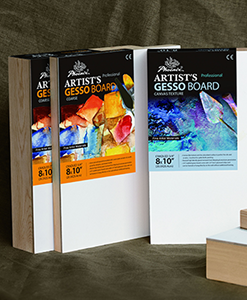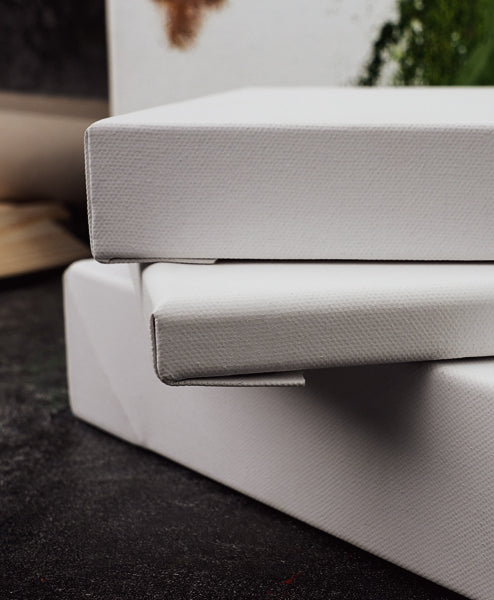Understanding Oil Painting Boards for Professional Portraits
Professional artists choose oil painting boards to achieve superior control in their work. Many search for "oil painting boards" to find surfaces that enhance oil colors' richness without warping or cracking. This guide helps you explore techniques for professional creators. You discover how painting boards outperform traditional canvases in portrait art, where precise skin tone mixing demands reliable support. Artists often pair these boards with oil pigments for alla prima techniques or multi-layer experiments. Phoenix Art Store offers high-quality options that rival industry leaders, providing texture and solvent resistance for pro-level results. You link back to our center guide on "art painting board" here for broader context.
Understanding Oil Painting Boards Types
Artists define oil painting boards as rigid surfaces designed for oil mediums, offering flat, non-flexible support that prevents sagging under heavy layers. You use these boards to maintain even texture and absorbency, ideal for detailed portrait work. Professionals prefer painting boards over stretched canvases because they avoid the "bounce" that disrupts fine brushstrokes.
You categorize oil painting boards into key types based on material and priming:
Hardboard Panels: You construct these from compressed wood fibers, such as MDF or tempered hardboard, and prime them with oil ground to provide slight absorbency. This surface allows smooth paint application, with Trekell highlighting its slick texture for gliding brushes.

Linen-Primed Panels: You mount fine-weave linen on sturdy Baltic birch or hardwood bases, then quadruple-prime with oil for a portrait-ready finish. Professionals value the natural texture that enhances light reflection, perfect for capturing the luminous quality of skin tones.
Canvas Boards: You combine the traditional feel of canvas with rigid backing, typically cardboard or hardboard coated with primed cotton or linen. These offer a portable, affordable option for daily practice or plein air portraits, with Trekell’s versions appealing to artists transitioning to pro levels.
|
Type |
Material |
Key Feature |
Pro Use in Portraits |
|
Hardboard |
Compressed fiber (MDF) |
Slight absorbency, slick surface |
You layer skin tones evenly; avoids cracking in multi-glaze experiments. |
|
Linen-Primed |
Linen on birch |
Fine weave, oil-primed |
You enhance glow in flesh highlights; texture boosts realism per Artefex. |
|
Canvas Boards |
Primed cotton/linen on hardboard |
Portable, fabric texture |
You practice alla prima outdoors; ideal for quick portrait sketches, per Trekell. |
Choosing the Right Oil Painting Board for Your Artwork
Artists evaluate oil painting boards based on medium compatibility, size, and technique. You assess priming first—oil ground provides the tooth for advanced adhesion, preventing beading in wet blends. Professionals demand solvent-resistant boards to handle turpentine or mediums without degradation, a feature Trekell and Artefex prioritize in their hardboard lines.
You consider size for portraits: small 8x10" boards suit studies, while larger 16x20" support detailed faces. Artwork boards with cradled backs add stability, avoiding flex during heavy impasto. Phoenix Art Store's oil painting boards stand out with their fiber-based construction, offering affordability and pro-grade priming.
You factor in budget and portability: canvas boards travel well for on-location portraits, while linen panels deliver premium texture for studio work. Refer back to our center guide on "art painting board" section here for more comparisons.
Steps you choose below:
1. Identify your technique—alla prima needs slick surfaces.
2. Test absorbency—prime if needed for custom control.
3. Match to pigments—Phoenix boards pair seamlessly with oils for even drying.
You select wisely to enhance your portrait outcomes.
Advanced Techniques: Alla Prima, Mixing Experiments, and Board Pairing
Professionals employ advanced techniques on oil painting boards to push creative boundaries. You execute alla prima—wet-on-wet painting in one session—on slick hardboard, allowing spontaneous blends for lively skin tones. Trekell recommends their oil-ground panels for this, as the surface grips paint without dragging, enabling quick fusion of warms and cools.
You conduct mixing experiments directly on boards: layer Alizarin Crimson + Yellow Ochre for base flesh, then add Ultramarine for shadows. Linen panels from Artefex enhance texture, amplifying light play in portraits— their weave catches glaze highlights for glowing cheeks. You pair boards with oils: hardboard's slight absorbency handles turpentine washes, preventing bleed in multi-layer skin builds.
You demand durable boards that withstand solvents, like Phoenix's fiber panels, which avoid warping in extended sessions. Experiment alla prima on these: mix Cadmium Red + white for rosy highlights, blending wet to mimic skin's subtlety.
This table details techniques with board recommendations:
|
Technique |
Board Type |
Key Benefit |
Pro Tip for Portraits |
|
Alla Prima |
Hardboard (oil-ground) |
Slick glide for wet blends |
You fuse tones swiftly; use for dynamic facial expressions, per Trekell. |
|
Layering Experiments |
Linen-Primed |
Texture enhances depth |
You glaze shadows; linen's weave adds realistic light refraction, as Artefex suggests. |
|
Solvent Washes |
Hardboard |
Absorbency for control |
You thin paints without damage; ideal for subtle skin gradients in diverse tones. |
You innovate with these to refine portrait mastery.
Brand and Pigment Comparisons: Oil Painting Boards for Pros
Professionals compare brands to select boards that complement advanced oil work. You evaluate priming, material—Artefex's linen panels offer fine weave for texture, while Trekell's hardboards provide lightweight archival support.
Phoenix Art Store's oil painting boards rival these with fiber-based construction and solvent-resistant priming, at competitive prices. You choose Phoenix for its balance: hardboard options grip oils for alla prima, linen variants enhance glaze luminosity in portraits.
Compare key boards:
|
Board Type |
Brand |
Material |
Feature |
Pro Mixing/Pairing Analysis |
|
Oil-Ground Hardboard |
Phoenix |
Fiber composite |
Solvent-resistant, warp-free |
You layer oils smoothly; pairs with Alizarin Crimson for skin depth without cracking. |
|
|
Trekell |
Baltic birch |
Slick texture, absorbent |
You blend wet-on-wet; excellent for alla prima, but Phoenix offers better affordability. |
|
|
Artefex |
MDF core |
High tooth for adhesion |
You experiment glazes; texture boosts light in portraits, matching Phoenix's versatility. |
|
Linen-Primed Panel |
Phoenix |
Linen on fiber |
Fine weave, oil-primed |
You enhance glow in flesh; linen captures highlights, ideal for advanced skin experiments. |
|
|
Trekell |
Linen on hardwood |
Quadruple-primed |
You achieve portrait-grade smoothness; Phoenix edges in cost for pro studios. |
|
|
Artefex |
Linen on hardboard |
Archival stability |
You build multi-layers; pairs with Ultramarine for shadows, rivaling Phoenix's resistance. |
Common Issues with Oil Painting Boards
Artists encounter problems like warping under heavy oil layers—choose solvent-resistant boards like Phoenix's to prevent this. You face cracking from poor priming; test gesso layers on hardboard for stability. Texture mismatches disrupt mixing—linen panels from Artefex solve this by enhancing glaze flow.
Professionals avoid solvent damage by selecting durable artwork boards—Phoenix's fiber composites withstand turpentine without degradation. If boards absorb too much, you prime extra coats for controlled blending in portraits.
You resolve these by experimenting on small panels first, ensuring your oil painting boards support advanced techniques.
Applications on Using Oil Painting Boards in Portrait Art
Artists apply oil painting boards to create compelling portraits. You build lifelike skin tones on hardboard, layering Yellow Ochre + Alizarin Crimson for warm bases. Professionals use alla prima on Trekell panels to fuse shadows swiftly, capturing emotional depth.
In portraits, you focus on skin diversity: mix Cadmium Red + Ultramarine on linen boards for rosy cheeks, adding texture for realistic light play per Artefex. Artwork boards like Phoenix's prevent warping, allowing multi-layer experiments—glaze cool blues for contours, evoking introspection.
You extend to full figures: pair boards with oils for balanced compositions, ensuring solvent resistance supports detailed mixing. Professionals appreciate how these boards enhance glow.
Artists master oil painting boards to elevate portraits with precision. You now select and apply these surfaces confidently, from alla prima blends to layered skin tones. Phoenix's options deliver pro-quality at value prices. Return to our pillar guide's "art painting board" here for more. Share your portrait experiences below—what board transformed your work?
FAQ: Addressing Common Oil Painting Board Questions
Can I Use Oil Paint Pastels on Painting Boards?
Yes, you can use oil paint pastels on painting boards, and professionals often do for mixed-media portraits. Oil pastels blend with oil paints, creating rich textures on surfaces like Phoenix’s hardboard panels. You apply pastels first for base color, then layer oils for depth—ensure the board has a primed, slightly absorbent surface to grip the waxy medium. Based on recent reviews, artists recommend sealing pastel layers with a fixative before oiling to prevent smudging, especially on linen-primed boards.
How Long Does Oil Paint Take to Dry on Painting Boards?
Oil paint drying time on painting boards varies, but you typically wait 2-7 days for a touch-dry surface, depending on thickness and conditions—full curing takes 6-12 months. Professionals note that hardboard absorbs oils slightly faster than linen panels, reducing drying to 2-4 days with thin layers, as per Blick Art Materials’ latest guide (August 2024). You speed drying with additives like cobalt driers, though Phoenix’s fiber boards naturally balance moisture, minimizing cracking. Temperature and humidity affect this—keep studios ventilated.










